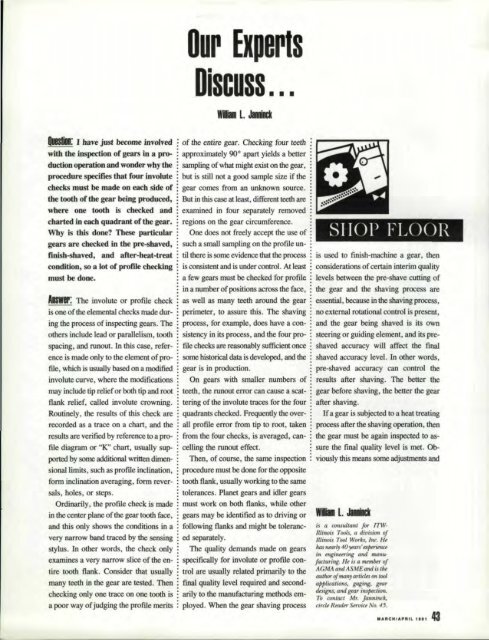Download PDF - Gear Technology magazine
Download PDF - Gear Technology magazine
Download PDF - Gear Technology magazine
Create successful ePaper yourself
Turn your PDF publications into a flip-book with our unique Google optimized e-Paper software.
Our Experts<br />
D _ ~ il·'S-iC--U.I'S·-S-'<br />
' .. ' J' I •••<br />
~: .I have Just become involved : of the entire gear. Cbec1dng four teeth<br />
with the inspection, of gears in. 8. pro- approximately 90° apart yields a better<br />
duction operation and wonder why the sampling of what might exist on the gear,<br />
procedure specifies tbat four mvolote but is still [lot a.good sample size if the<br />
checks most be made on each side of gear comes from an unknown source.<br />
the tooth of the gear being produced, : But in dlis case at least, different teeth are<br />
where one tooth. is cheeked and: examined in four separately removed<br />
cluu1ed iio each qua.dmnt of the gear. regions on the gear circumference .<br />
Why is this done? Thesepa_rticular One does not freely accept the use of SII()P<br />
gears are cheeked in the pre.;shaved, such a small sampling on the profile UIlfmisb-shaved,<br />
and Lfter-heat-tr·eat til there is some evideneejhat the process is used to finish-machine a gear , then<br />
condition, so a lot .of prDfile checking is consistent and is under control. At least • considerations ofcertain interim quality<br />
must be dDne.<br />
a few gears must be checked for profile levels between the pre-shave cutting of<br />
in a number of positions across the face, the gear and the shaving process are<br />
AllIer': The inv.olute or profile check<br />
as well as many teeth around the gear<br />
is one oftl:te elemental cheeks made dur- perimeter, to assure this ...The shaving<br />
ing the process of inspecting gears ..The process, for example, does have a CaRothers<br />
include lead or parallelism,. tooth sistency in its process, and the four prospacing,<br />
and runout ..In. dris case, refer- file checks are reasonably sufficient once .<br />
ence is made only to the element of pro- . some historical data is developed, and the ~<br />
file. wltichis usually based ana modified gear is in production.<br />
involute curve, where the modifications On gears with smaller numbers of<br />
teeth, the runout error can cause 8. scat-<br />
tering of the involute traces for the four<br />
quadrants checked, Frequently the overall<br />
profile error from tip to mot,taken<br />
from the four checks, is averaged, cancelling<br />
the runout effect.<br />
Then, of course, the same inspection<br />
procedure must be done for the opposite<br />
tooth flaak, usuaHy working to the same<br />
tolerances ..Planet gears and idlergears<br />
must work on both flanks, while other<br />
gears may be identified .ClS to driving or<br />
foUowing flanks and might be toleranced<br />
separately.<br />
The quality demands made ongea:rs<br />
specifically for involute or profile control<br />
are usually related primarily to. the<br />
final quality level required and secondariJy<br />
to the manufacturing methods employed.<br />
When. the gear shaving process<br />
may include tip relief,or both tip and root<br />
flank relief, called involute crowning ..<br />
Routinely. the results of this check are<br />
recorded as a trace ana chart,and the<br />
results are verified by reference to a pro--<br />
file diagram Dr .oK" chart, usually supported<br />
by some additional, written dimensional<br />
limits, such as profile inclination,<br />
fonn inclination averagiag, form reversals,<br />
holes, or steps.<br />
Ordinarily, the profile dleck is made<br />
in the center plane oftl:t.egear tooth face,<br />
and this only shows the conditions in a<br />
very narrow band traced by the sensing<br />
stylUS.. In other words, the check only<br />
examines a very narrow slice of the entire<br />
tooth flank. Consider that usually<br />
many teeth in the gear are tested ..Then<br />
checking .only one trace on one tooth is<br />
a poor way of'judgingtae profile merits<br />
FI.J()(»){<br />
essential, because in the shaving process,<br />
no external rotational contra] is present,<br />
and the gear being shaved is its own<br />
steering or guiding element, and its preshaved<br />
accuracy will affect me final<br />
shaved accuracy level. In other words,<br />
pre-shaved accuracy can cantril] Ihe<br />
results after shaving. The better the<br />
gear before shaving, the better the gear<br />
after shaving ..<br />
If a gear is subjected. to a heat treating<br />
process after the shaving operation, then<br />
the gear must be again inspected toassure<br />
the final quality level is met. Obviously<br />
this means some adjusttnents and<br />
LJ Yi<br />
is a consultan: for [TW·<br />
Illinois Tools, a divisilY!l of<br />
Illinois Tool Works, Inc. He<br />
11m nearly 40 y«lTS' txperi.ence<br />
in mgitlLmng and manu.·<br />
facturing. He is amnnbl!T .of<br />
AGMA and ASME and is 1M<br />
tl'!Ltlwr ·oJmany articles Oflitool<br />
applirotiom,. gaging. gear<br />
tiesigrn, and gear inspection.<br />
To cO'Illad Mr. Jaflininclt,<br />
circle Rtmkr Seroic« No. 45.<br />
IIA:~CIIIAPIlIL nil 43
















